
An electronic calculator is typically a portable electronic device used to perform calculations, ranging from basic arithmetic to complex mathematics.
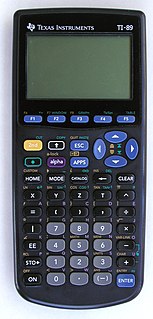
The TI-89 and the TI-89 Titanium are graphing calculators developed by Texas Instruments (TI). They are differentiated from most other TI graphing calculators by their computer algebra system, which allows symbolic manipulation of algebraic expressions—equations can be solved in terms of variables, whereas the TI-83/84 series can only give a numeric result.
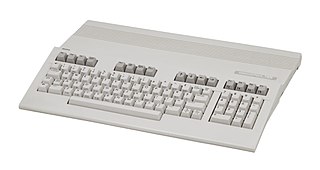
The Commodore 128, also known as the C128, C-128, C= 128, is the last 8-bit home computer that was commercially released by Commodore Business Machines (CBM). Introduced in January 1985 at the CES in Las Vegas, it appeared three years after its predecessor, the bestselling Commodore 64.
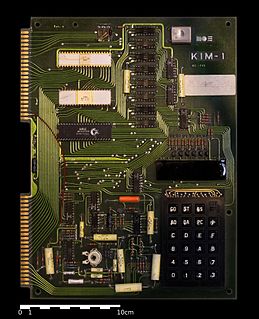
The KIM-1, short for Keyboard Input Monitor, is a small 6502-based single-board computer developed and produced by MOS Technology, Inc. and launched in 1976. It was very successful in that period, due to its low price and easy-access expandability.

The VTech Laser 200 was an early 8-bit home computer from 1983, also sold as the Salora Fellow, the Seltron 200 in Hungary and Italy, the Smart-Alec Jr. by Dynasty Computer Corporation in Dallas, Texas for the USA, the Texet TX8000A, and the Dick Smith VZ 200 and the VTech VZ 200.

The Sharp PC-1251 was a small pocket computer that was also marketed as the Tandy or TRS-80 Pocket Computer PC-3.
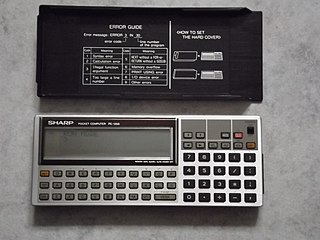
The Sharp PC-1350 is a small pocket computer manufactured by Sharp. The PC-1350 was introduced in 1984 and was used by engineers, and favored by programmers for its programming and graphical capabilities. It was superseded in 1987 by the PC-1360, which featured one additional RAM expansion port, improved BASIC, floppy disk capability, and a faster CPU.

The Sharp PC-1500 was a pocket computer produced by Sharp between 1981 and 1985. A rebadged version was also sold as the TRS-80 Pocket Computer PC-2.

The Sharp PC-1401 is a small pocket computer manufactured by Sharp. It was introduced in 1983 and is one of the first combinations of scientific calculator and portable computer with BASIC interpreter/bytecode compiler. The PC-1402 has the same features but includes 10K of RAM.
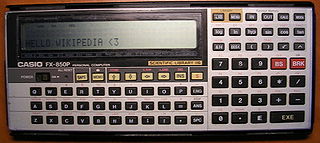
The Casio FX-850P is a scientific calculator introduced in 1987 and sold until 1999.

The Tandy Pocket Computer or TRS-80 Pocket Computer is one of a line of 1980s small pocket computers—calculator-sized programmable computing devices—sold by Tandy Corporation under the "Tandy" or "Radio Shack TRS-80" brands.
There are various ways in which calculators interpret keystrokes. These can be categorized into two main types:
Programmable calculators are calculators that can automatically carry out a sequence of operations under control of a stored program. Most are Turing complete, and, as such, are theoretically general-purpose computers. However, their user interfaces and programming environments are specifically tailored to make performing small-scale numerical computations convenient, rather than general-purpose use.
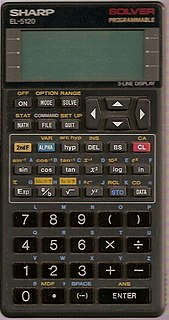
The Sharp EL-5120 is a scientific programmable calculator. It has about 1 KB of total RAM available to the user, and has 4 basic operational modes:

The Sharp PC-E500S was a 1995 pocket computer by Sharp Corporation and was the successor to the 1989 PC-E500 model, featuring a 2.304 MHz CMOS CPU.
HP 39/40 series are graphing calculators from Hewlett-Packard, the successors of HP 38G. The series consists of six calculators, which all have algebraic entry modes, and can perform numeric analysis together with varying degrees of symbolic calculation. All calculators in this series are aimed at high school level students and are characterized by their ability to download APLETs or E-lessons. These are programs of varying complexity which are generally intended to be used in the classroom to enhance the learning of mathematics by the graphical and/or numerical exploration of concepts.

The Sharp PC-1600 was a pocket computer introduced by Sharp in 1986 as a successor to the PC-1500. The PC-1600 provided compatibility with its predecessor through the use of a slave CPU that could run assembly language programs targeting the older machine. It could also switch into a compatibility mode so that programs written for the single line display of the PC-1500 could work with the four line display of the PC-1600.
The IBM Personal Computer Basic, commonly shortened to IBM BASIC, is a programming language first released by IBM with the IBM Personal Computer, Model 5150 in 1981. IBM released four different versions of the Microsoft BASIC interpreter, licensed from Microsoft for the PC and PCjr. They are known as Cassette BASIC, Disk BASIC, Advanced BASIC (BASICA), and Cartridge BASIC. Versions of Disk BASIC and Advanced BASIC were included with IBM PC DOS up to PC DOS 4. In addition to the features of an ANSI standard BASIC, the IBM versions offered support for the graphics and sound hardware of the IBM PC line. Source code could be typed in with a full-screen editor, and very limited facilities were provided for rudimentary program debugging. IBM also released a version of the Microsoft BASIC compiler for the PC, concurrently with the release of PC DOS 1.10 in 1982.
The Sharp pocket computer character sets are a number of 8-bit character sets used by various Sharp pocket computers and calculators in the 1980s and mid 1990s.

The Casio Algebra FX series was a line of graphing calculators manufactured by Casio Computer Co., Ltd from 1999 to 2003. They were the successor models to the CFX-9970G, the first Casio calculator with computer algebra system, or CAS, a program for symbolic manipulation of mathematical expressions. The calculators were discontinued and succeeded by the Casio ClassPad 300 in 2003.

















